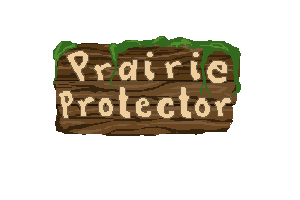
The following four lessons are provided to connect the Prairie Protector digital game with broader learning objectives.
The following lessons are provided to connect the Prairie Protector digital game with broader learning objectives. Click on the headings below to access each lesson in Google Doc format. All lessons are available for download in a single Google Doc using the lesson pack link at the bottom of the page.
Lesson 1
Introducing Prairie Protector and Comparing Gameplay Strategies
Overview
In this lesson, learners play the Prairie Protector game and reflect on their gameplay decisions and describe the tools and land management strategies they used to mitigate encroachment by woody plant species.
Learning Objectives
-
Design a land management strategy to mitigate the spread of woody species in the Prairie Protector game
-
Reflect and iteratively adjust the land management strategy based on feedback from the game
-
Provide a justification for gameplay decisions and modifications made in the land management strategy
Lesson 2
Comparing the Game to Real-World Land Management Challenges
Overview
In this lesson, learners will compare Prairie Protector gameplay with the realities faced by land managers who are challenged with mitigating the spread of woody species to maintain rangeland productivity and sustain grassland biodiversity.
Learning Objectives
-
Examine the challenges that land managers in the Great Plains face as ranchland productivity and biodiversity are threatened by the increasing encroachment of woody species.
-
Compare and contrast the Prairie Protector game with more complex challenges facing land managers who are mitigating the threat of woody species encroachment.
Lesson 3
Looking Back: How Have Cultural Beliefs about Fire Changed Over Time?
Overview
In this lesson, learners will explore the cultural shift from acceptance to aversion to fire on the landscape. Learners will research indigenous peoples' use of fire as a land management tool in the Great Plains and compare and contrast this historical approach to fire with colonizing settlers’ views.
Learning Objectives
-
Summarize the indigenous use of fire as a land management tool in the U.S.
-
Compare and contrast indigenous and colonial perceptions of fire
-
Craft a scientific argument supported by evidence for how colonial perceptions and uses of fire as a land management tool have influenced the wildfire regime in the U.S.
Lesson 4
A Systems Thinking Approach in Mitigating Woody Species Encroachment
Overview
In this lesson, we will use a tool for drawing and playing with systems called Loopy. Learners will use the knowledge they have gained to model system elements and interactions to explain the issue of woody encroachment in the Great Plains and predict problems that this encroachment will cause if left unchecked. Learners will look for leverage points in their model where humans can take action to change the system.
Learning Objectives
- Model a personally meaningful system including its components and interactions
- Compare model system behavior to real-world system behavior
- Modify system model to more closely match real-world system interactions
- Apply iterative system modeling process to model the impacts of woody encroachment
Prairie Protector Lesson Pack
-
Includes lessons 1-4 in a single Google Document.
- Prairie Protector digital game (external website link)
- Lesson 1: Introducing Prairie Protector and Comparing Gameplay Strategies
- Lesson 2: Comparing the Game to Real-World Land Management Challenges
- Lesson 3: Looking Back: How Have Cultural Beliefs about Fire Changed Over Time?
- Lesson 4: A Systems Thinking Approach in Mitigating Woody Species Encroachment
- Lesson Pack (All 4 lessons)